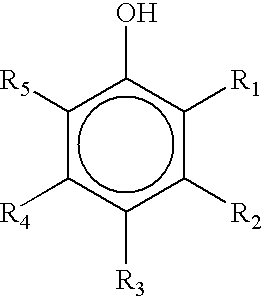Compositions having enhanced deposition of a topically active compound on a surface
a topically active compound and composition technology, applied in the field of compositions, can solve the problems of high cost, difficult simultaneous cleaning and deposition of topically active ingredients, and the practical limit of incorporating a high level of active compound with traditional, and achieves rapid and substantial benefits.
- Summary
- Abstract
- Description
- Claims
- Application Information
AI Technical Summary
Benefits of technology
Problems solved by technology
Method used
Image
Examples
example 1
demonstrates the surprising improvement in log reduction of bacteria populations provided by an inventive composition compared to currently available commercial antibacterial compositions. Thus, an aqueous composition containing triclosan in SLS, at 100% saturation, offers significantly greater antibacterial efficacy than any of the three commercial products tested, against Gram positive and against Gram negative microorganisms, both of which can present a significant health threat to consumers.
example 2
This example demonstrates that the antibacterial activity-of an inventive composition is attributable to the active antibacterial agent, as opposed to the surfactant. Test compositions A-1 and A-2 were prepared. Composition A-1 is a solution containing 0.3% triclosan, 1.35% ammonium lauryl sulfate, with the balance being water. Composition A-1 is 100% saturated with triclosan. Composition A-2 is a “placebo,” i.e., an aqueous 1.35% ammonium lauryl sulfate solution that is free of the active antibacterial agent.
Log Reduction at 5 minutes(time kill)TriclosanS.E.K.S.Product(%)% Saturation3)aureuscolipneum.chol.A-10.30100>3.613.16>4.393.73A-200>3.610.250.150.04
The inventive composition A-1 clearly provided an excellent, broad spectrum antibacterial activity, whereas the “placebo” composition A-2 exhibited an extremely limited spectrum of activity. Composition A-2 has especially poor efficacy against Gram negative organisms. Control of Gram negative organisms is of particular concern to c...
example 3
In this example, a solvent, (i.e., propylene glycol (PG)) was used to solubilize triclosan in an aqueous carrier. No hydrotrope or surfactant was present. Composition A-3 contained 0.0872% by weight triclosan, 47.5% aqueous PG, and the balance being water. Composition A-3 was 100% saturated with triclosan and is a composition of the present invention. Test composition A-4 was a “placebo” consisting of 47.5% PG, by weight, and the balance water. This example illustrates an added advantage of including an optional hydric solvent in the composition. In particular, it was observed that the excellent broad spectrum activity illustrated in earlier examples at contact times of 1 and 5 minutes can be achieved in the presence of the hydric solvent at a contact time of 30 seconds. This example further demonstrates that the antibacterial activity of a present composition is unambiguously attributable to the presence of the antibacterial agent.
Log Reduction at 30 seconds(time kill)TriclosanS.E....
PUM
| Property | Measurement | Unit |
|---|---|---|
| Fraction | aaaaa | aaaaa |
| Fraction | aaaaa | aaaaa |
| Fraction | aaaaa | aaaaa |
Abstract
Description
Claims
Application Information
 Login to View More
Login to View More - R&D
- Intellectual Property
- Life Sciences
- Materials
- Tech Scout
- Unparalleled Data Quality
- Higher Quality Content
- 60% Fewer Hallucinations
Browse by: Latest US Patents, China's latest patents, Technical Efficacy Thesaurus, Application Domain, Technology Topic, Popular Technical Reports.
© 2025 PatSnap. All rights reserved.Legal|Privacy policy|Modern Slavery Act Transparency Statement|Sitemap|About US| Contact US: help@patsnap.com



